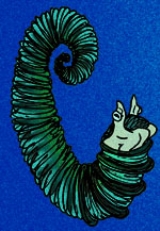
Barremian
Encyclopedia
The Barremian is an age in the geologic timescale (or a chronostratigraphic
stage) between 130.0 ± 1.5 Ma (million years ago) and 125.0 ± 1.0 Ma). It is a subdivision of the Early Cretaceous
epoch
(or Lower Cretaceous series
). It is preceded by the Hauterivian
and followed by the Aptian
stage.
The Barremian falls in the Gallic
epoch, a subdivision of the Cretaceous
that is no longer used by the ICS
. It overlaps the lower part of the Urgonian stage, which is sometimes used in western European stratigraphy. In North America
, the late Coahulian and the early Comanchean correspond to the Barremian. In New Zealand
, it falls within the Mokoiwian, and in Japan
it corresponds to the late Aritan.
for the Barremian stage is in the vicinity of the village of Barrême
, Alpes-de-Haute-Provence
, France
. Henry Coquand defined the stage and named it in 1873.
The base of the Barremian is determined by the first appearance of the ammonite
s Spitidiscus hugii and Spitidiscus vandeckii. The end of the Barremian is determined by the geomagnetic reversal
at the start of the M0r chronozone
, which is biologically near the first appearance of the ammonite Paradeshayesites oglanlensis
.
In the Tethys domain
, the Barremian stage contains eleven ammonite biozone
s:
—especially regarding bird
s, mammal
s and pterosaur
s—derived from the famous Yixian Formation
of China
, part of which dates from this stage.
Chondrichthyes
†Cerapoda
†Sauropoda
Theropoda
†Thyreophora
†Pterosaur
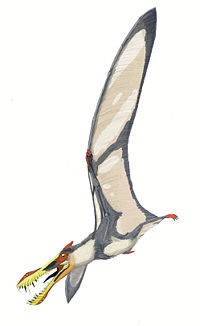
. (2006): Assessment of diachronism of biostratigraphic boundaries by magnetochronological calibration of zonal scales for the Lower Cretaceous of the Tethyan and Boreal belts. Doklady Earth Sciences 409(6): 843-846.
Chronostratigraphy
Chronostratigraphy is the branch of stratigraphy that studies the age of rock strata in relation to time.The ultimate aim of chronostratigraphy is to arrange the sequence of deposition and the time of deposition of all rocks within a geological region, and eventually, the entire geologic record of...
stage) between 130.0 ± 1.5 Ma (million years ago) and 125.0 ± 1.0 Ma). It is a subdivision of the Early Cretaceous
Early Cretaceous
The Early Cretaceous or the Lower Cretaceous , is the earlier or lower of the two major divisions of the Cretaceous...
epoch
Epoch (geology)
An epoch is a subdivision of the geologic timescale based on rock layering. In order, the higher subdivisions are periods, eras and eons. We are currently living in the Holocene epoch...
(or Lower Cretaceous series
Series (stratigraphy)
Series are subdivisions of rock layers made based on the age of the rock and corresponding to the dating system unit called an epoch, both being formally defined international conventions of the geological timescale. A series is therefore a sequence of rock depositions defining a...
). It is preceded by the Hauterivian
Hauterivian
The Hauterivian is, in the geologic timescale, an age in the Early Cretaceous epoch or a stage in the Lower Cretaceous series. It spans the time between 136.4 ± 2 Ma and 130 ± 1.5 Ma...
and followed by the Aptian
Aptian
The Aptian is an age in the geologic timescale or a stage in the stratigraphic column. It is a subdivision of the Early or Lower Cretaceous epoch or series and encompasses the time from 125.0 ± 1.0 Ma to 112.0 ± 1.0 Ma , approximately...
stage.
The Barremian falls in the Gallic
Gallic epoch
The Gallic epoch is an obsolete epoch of the Cretaceous, encompassing the Barremian, Aptian, Albian, Cenomanian and Turonian faunal stages....
epoch, a subdivision of the Cretaceous
Cretaceous
The Cretaceous , derived from the Latin "creta" , usually abbreviated K for its German translation Kreide , is a geologic period and system from circa to million years ago. In the geologic timescale, the Cretaceous follows the Jurassic period and is followed by the Paleogene period of the...
that is no longer used by the ICS
International Commission on Stratigraphy
The International Commission on Stratigraphy , sometimes referred to by the unofficial "International Stratigraphic Commission" is a daughter or major subcommittee grade scientific daughter organization that concerns itself with stratigraphy, geological, and geochronological matters on a global...
. It overlaps the lower part of the Urgonian stage, which is sometimes used in western European stratigraphy. In North America
North America
North America is a continent wholly within the Northern Hemisphere and almost wholly within the Western Hemisphere. It is also considered a northern subcontinent of the Americas...
, the late Coahulian and the early Comanchean correspond to the Barremian. In New Zealand
New Zealand
New Zealand is an island country in the south-western Pacific Ocean comprising two main landmasses and numerous smaller islands. The country is situated some east of Australia across the Tasman Sea, and roughly south of the Pacific island nations of New Caledonia, Fiji, and Tonga...
, it falls within the Mokoiwian, and in Japan
Japan
Japan is an island nation in East Asia. Located in the Pacific Ocean, it lies to the east of the Sea of Japan, China, North Korea, South Korea and Russia, stretching from the Sea of Okhotsk in the north to the East China Sea and Taiwan in the south...
it corresponds to the late Aritan.
Stratigraphic definitions
The original type localityType locality (geology)
Type locality , also called type area or type locale, is the where a particular rock type, stratigraphic unit, fossil or mineral species is first identified....
for the Barremian stage is in the vicinity of the village of Barrême
Barrême
Barrême is a commune in the Alpes-de-Haute-Provence department in southeastern France.-Geography:The village lies in the middle of the commune, near the confluence of the rivers Asse de Clumanc, Asse de Blieux, and Asse de Moriez, tributaries of the Asse.-Regional Geology:Barreme is a young...
, Alpes-de-Haute-Provence
Alpes-de-Haute-Provence
Alpes-de-Haute-Provence is a French department in the south of France, it was formerly part of the province of Provence.- History :Nord-de-Provence was one of the 83 original departments created during the French Revolution on 4 March 1790...
, France
France
The French Republic , The French Republic , The French Republic , (commonly known as France , is a unitary semi-presidential republic in Western Europe with several overseas territories and islands located on other continents and in the Indian, Pacific, and Atlantic oceans. Metropolitan France...
. Henry Coquand defined the stage and named it in 1873.
The base of the Barremian is determined by the first appearance of the ammonite
Ammonite
Ammonite, as a zoological or paleontological term, refers to any member of the Ammonoidea an extinct subclass within the Molluscan class Cephalopoda which are more closely related to living coleoids Ammonite, as a zoological or paleontological term, refers to any member of the Ammonoidea an extinct...
s Spitidiscus hugii and Spitidiscus vandeckii. The end of the Barremian is determined by the geomagnetic reversal
Geomagnetic reversal
A geomagnetic reversal is a change in the Earth's magnetic field such that the positions of magnetic north and magnetic south are interchanged. The Earth's field has alternated between periods of normal polarity, in which the direction of the field was the same as the present direction, and reverse...
at the start of the M0r chronozone
Chronozone
A chronozone or chron is a slice of time that begins at a given identifiable event and ends at another. In the fossil record such tracer events are usually keyed to disappearance of a widely distributed and rapidly changing species or the appearance of such a species in the geological record...
, which is biologically near the first appearance of the ammonite Paradeshayesites oglanlensis
Paradeshayesites
Paradeshayesites is an extinct genus of cephalopod belonging to the Ammonite subclass....
.
Subdivision
The Barremian is often subdivided into two substages or subages, Lower/Early and Upper/Late Barremian.In the Tethys domain
Tethys Ocean
The Tethys Ocean was an ocean that existed between the continents of Gondwana and Laurasia during the Mesozoic era before the opening of the Indian Ocean.-Modern theory:...
, the Barremian stage contains eleven ammonite biozone
Biozone
Biostratigraphic units or Biozones are intervals of geological strata that are defined on the basis of their characteristic fossil taxa....
s:
- zone of Pseudocrioceras waagenoidesPseudocriocerasPseudocrioceras is an extinct genus of ammonite cephalopod. It has been found in strata from the Barremian - Aptian age of Colombia. This genus was an actively mobile carnivore with a nektonic lifestyle....
- zone of Colchidites sarasini
- zone of Imerites giraudi
- zone of Hemihoplites feraudianus
- zone of Gerhardtia sertousi
- zone of Ancyloceras vandenheckiiAncylocerasAncyloceras is an extinct genus of heteromorph ammonite cephalopod found throughout the world during the Lower Cretaceous, from the Lower Barremian epoch until the genus' extinction during the Lower Aptian....
- zone of Coronites darsi
- zone of Kotetishvilia compressissima
- zone of Nicklesia pulchella
- zone of Nicklesia nicklesi
- zone of Spitidiscus hugii
Palaeontology
Much knowledge about the Barremian faunaFauna
Fauna or faunæ is all of the animal life of any particular region or time. The corresponding term for plants is flora.Zoologists and paleontologists use fauna to refer to a typical collection of animals found in a specific time or place, e.g. the "Sonoran Desert fauna" or the "Burgess shale fauna"...
—especially regarding bird
Bird
Birds are feathered, winged, bipedal, endothermic , egg-laying, vertebrate animals. Around 10,000 living species and 188 families makes them the most speciose class of tetrapod vertebrates. They inhabit ecosystems across the globe, from the Arctic to the Antarctic. Extant birds range in size from...
s, mammal
Mammal
Mammals are members of a class of air-breathing vertebrate animals characterised by the possession of endothermy, hair, three middle ear bones, and mammary glands functional in mothers with young...
s and pterosaur
Pterosaur
Pterosaurs were flying reptiles of the clade or order Pterosauria. They existed from the late Triassic to the end of the Cretaceous Period . Pterosaurs are the earliest vertebrates known to have evolved powered flight...
s—derived from the famous Yixian Formation
Yixian Formation
The Yixian Formation is a geological formation in Jinzhou, Liaoning, People's Republic of China, that spans 11 million years during the early Cretaceous period...
of China
China
Chinese civilization may refer to:* China for more general discussion of the country.* Chinese culture* Greater China, the transnational community of ethnic Chinese.* History of China* Sinosphere, the area historically affected by Chinese culture...
, part of which dates from this stage.
Neocoleoids
| Neocoleoids of the Barremian | ||||
|---|---|---|---|---|
| Taxa | Presence | Location | Description | Images |
Maioteuthis |
||||
Neololigosepia |
||||
Oxyteuthis Oxyteuthis Oxyteuthis is a genus of belemnite, an extinct group of cephalopods.... |
||||
†Belemnites
| Belemnites of the Barremian | ||||
|---|---|---|---|---|
| Taxa | Presence | Location | Description | Images |
Curtohibolites Curtohibolites Curtohibolites is a genus of belemnite, an extinct group of cephalopods.... |
 |
|||
Neohibolites Neohibolites Neohibolites is a genus of belemnite, an extinct group of cephalopods.... |
||||
Oxyteuthis Oxyteuthis Oxyteuthis is a genus of belemnite, an extinct group of cephalopods.... |
||||
Nautiloidea
| Nautiloids of the Barremian | ||||
|---|---|---|---|---|
| Taxa | Presence | Location | Description | Images |
Eucymatoceras |
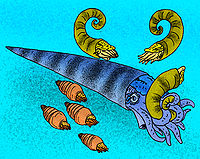 |
|||
Palelialia Palelialia Palelialia is an extinct genus of prehistoric nautiloid. The nautiloids are a subclass of shelled cephalopods that were once diverse and numerous but are now represented by only a handful of species.-References:... |
||||
Pseudaturoidea |
||||
ChondrichthyesChondrichthyesChondrichthyes or cartilaginous fishes are jawed fish with paired fins, paired nares, scales, two-chambered hearts, and skeletons made of cartilage rather than bone...
- Hexanchidae: Notidanodon lanceolatus, Notorynchus aptiensis
†CerapodaCerapodaNeornithischia is a clade of the dinosaur order Ornithischia. They are the sister group of the Thyreophora within the clade Genasauria. Neornithischians are united by having a thicker layer of asymmetrical enamel on the inside of their lower teeth...
| Cerapoda Cerapoda Neornithischia is a clade of the dinosaur order Ornithischia. They are the sister group of the Thyreophora within the clade Genasauria. Neornithischians are united by having a thicker layer of asymmetrical enamel on the inside of their lower teeth... of the Barremian |
||||
|---|---|---|---|---|
| Taxa | Presence | Location | Description | Images |
Jinzhousaurus Jinzhousaurus Jinzhousaurus is a genus of hadrosauroid dinosaur of the Early Cretaceous of China.The type species is Jinzhousaurus yangi. The generic name refers to the town Jinzhou. The specific name honours Yang Zhongjian as the founder of Chinese paleontology... |
China |  |
||
Ponerosteus Ponerosteus Ponerosteus is a dubious genus of archosaur which was first identified as "Iguanodon exogirarum" by Antonin Fritsch in 1878 for a specimen from the Cenomanian . He later renamed it Procerosaurus, unaware that this name was already in use... |
Czech Republic | |||
Fukuisaurus Fukuisaurus Fukuisaurus is a genus of herbivorous dinosaur from the Early Cretaceous. It was an ornithopod which lived in what is now Japan.... |
Japan | |||
Hypsilophodon Hypsilophodon Hypsilophodon is an ornithopod dinosaur genus from the Early Cretaceous period of Europe. It was a small bipedal animal with an herbivorous or possibly omnivorous diet... |
England, Portugal |  |
||
Jeholosaurus Jeholosaurus Jeholosaurus is a genus of ornithischian dinosaur from the Early Cretaceous Period. It is thought to have been a small ornithopod presumably related to the hypsilophodonts, and an herbivore. Although the back teeth are like those of a plant eater, the front premaxillary teeth are sharp and pointed... |
China | |||
Cedrorestes Cedrorestes Cedrorestes is a genus of iguanodontian dinosaur from the Early Cretaceous of Utah... |
Utah, USA | |||
Valdosaurus Valdosaurus Valdosaurus is a genus of bipedal herbivorous iguanodont ornithopod dinosaur found on the Isle of Wight and elsewhere in England. It lived during the Early Cretaceous.-Discovery and naming:... |
Europe, Africa | |||
Dakotadon Dakotadon Dakotadon is a genus of iguanodont dinosaur from the Barremian-age Lower Cretaceous Lakota Formation of South Dakota, USA, known from a partial skull. It was first described in 1989 as Iguanodon lakotaensis, by David B. Weishampel and Philip R. Bjork. Its assignment has been controversial. Some... |
South Dakota, USA | |||
Dollodon Dollodon Dollodon is a genus of ornithopod dinosaur that lived in the Barremian and possibly the early Aptian ages of the Early Cretaceous Period of Europe. Its remains are known from Belgium , England and possibly Germany... |
Belgium, Germany, England |  |
||
Iguanodon Iguanodon Iguanodon is a genus of ornithopod dinosaur that lived roughly halfway between the first of the swift bipedal hypsilophodontids and the ornithopods' culmination in the duck-billed dinosaurs... |
Europe, Africa, Asia, North America | |||
Osmakasaurus Osmakasaurus Osmakasaurus is a genus of herbivorous iguanodontian dinosaur. It is a basal iguanodontian which lived during the lower Cretaceous period in what is now Buffalo Gap of South Dakota, USA. It is known from the Chilson Member of the Lakota Formation. This genus was named by Andrew T. McDonald in 2011... |
South Dakota, USA | |||
Siluosaurus Siluosaurus Siluosaurus is a genus of ornithopod dinosaur from the Barremian-Albian-age Lower Cretaceous Xinminbao Group of Gansu, China. It is based on IVPP V.11117 , two teeth... |
Gansu, China | |||
Hongshanosaurus Hongshanosaurus Hongshanosaurus is a genus of psittacosaurid ceratopsian dinosaur from the Early Cretaceous Period of eastern Asia. Although two skulls are the only fossil material described, comparisons with close relatives suggest it was a small, bipedal herbivore with a bony beak on the end of both upper and... |
Liaoning, China | |||
Psittacosaurus Psittacosaurus Psittacosaurus is a genus of psittacosaurid ceratopsian dinosaur from the Early Cretaceous Period of what is now Asia, about 130 to 100 million years ago. It is notable for being the most species-rich dinosaur genus... |
China, Mongolia, Russia, possibly Thailand | 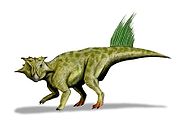 |
||
†Other Cerapods
| Other Cerapods of the Barremian | ||||
|---|---|---|---|---|
| Taxa | Presence | Location | Description | Images |
Stenopelix Stenopelix Stenopelix is a genus of small ornithischian dinosaur from the Early Cretaceous of Germany. It was perhaps a basal ceratopsian from the Barremian Stage of the Cretaceous period, sometime between 130 and 125 million years ago... |
Germany | |||
Hongshanosaurus Hongshanosaurus Hongshanosaurus is a genus of psittacosaurid ceratopsian dinosaur from the Early Cretaceous Period of eastern Asia. Although two skulls are the only fossil material described, comparisons with close relatives suggest it was a small, bipedal herbivore with a bony beak on the end of both upper and... |
Liaoning, China | |||
Liaoceratops Liaoceratops Liaoceratops, meaning "Liao Horned Face", is a ceratopsian dinosaur believed to be an early relative of the horned ceratopsids. It lived in the early Cretaceous, some 130 million years ago. It was discovered in China by a team of American and Chinese scientists... |
Liaoning, China | |||
Psittacosaurus Psittacosaurus Psittacosaurus is a genus of psittacosaurid ceratopsian dinosaur from the Early Cretaceous Period of what is now Asia, about 130 to 100 million years ago. It is notable for being the most species-rich dinosaur genus... |
China, Mongolia, Russia, possibly Thailand | |||
†SauropodaSauropodaSauropoda , or the sauropods , are an infraorder of saurischian dinosaurs. They had long necks, long tails, small heads , and thick, pillar-like legs. They are notable for the enormous sizes attained by some species, and the group includes the largest animals to have ever lived on land...
| Marginocephalia Marginocephalia Marginocephalia is a clade of ornithischian dinosaurs that includes the thick-skulled pachycephalosaurids, and horned ceratopsians. They were all herbivores, walking on two or four legs, and are characterized by a bony ridge or frill the back of the skull... of the Barremian |
||||
|---|---|---|---|---|
| Taxa | Presence | Location | Description | Images |
Cedarosaurus Cedarosaurus Cedarosaurus was a nasal-crested macronarian dinosaur genus from the Early Cretaceous Period . It was a sauropod which lived in what is now Utah... |
Utah, USA | |||
Aragosaurus Aragosaurus Aragosaurus was a genus of sauropod dinosaur from the Early Cretaceous period of Galve, province of Teruel, in the autonomous territory of Aragón, Spain.... |
Aragón, Spain | |||
Amargasaurus Amargasaurus Amargasaurus is a genus of dicraeosaurid sauropod dinosaur from the Early Cretaceous Period of what is now South America. It was small for a sauropod, reaching 10 meters length. It would have been a quadrupedal herbivore with a long, low skull on the end of a long neck, much like its relative... |
Neuquén, Argentina | |||
Histriasaurus Histriasaurus Histriasaurus was a genus of dinosaur from the Early Cretaceous . Its fossils, holotype WN V-6, were found in Croatia, and described in 1998 by Dalla Vecchia. It was a diplodocoid sauropod, related to, but more primitive than, Rebbachisaurus... |
Croatia | |||
Eucamerotus Eucamerotus Eucamerotus was a genus of sauropod dinosaur from the Barremian-age Lower Cretaceous Wessex Formation of the Isle of Wight, England. It is known from vertebral remains, and a partial skeleton has been referred, although this has not been accepted... |
Isle of Wight, England | |||
Oplosaurus Oplosaurus Oplosaurus was a genus of sauropod dinosaur from the Barremian-age Lower Cretaceous Wessex Formation of the Isle of Wight, England... |
Isle of Wight, England | |||
Amargatitanis Amargatitanis Amargatitanis is a genus of titanosaur sauropod dinosaur from the Barremian-age La Amarga Formation of Neuquén, Argentina... |
Neuquén, Argentina | |||
TheropodaTheropodaTheropoda is both a suborder of bipedal saurischian dinosaurs, and a clade consisting of that suborder and its descendants . Dinosaurs belonging to the suborder theropoda were primarily carnivorous, although a number of theropod groups evolved herbivory, omnivory, and insectivory...
| Theropods of the Barremian | ||||
|---|---|---|---|---|
| Taxa | Presence | Location | Description | Images |
Fukuiraptor Fukuiraptor Fukuiraptor was a medium-sized carnivore of the Early Cretaceous that lived in what is now Japan. Scientists first thought it was a member of the Dromaeosauridae, but after studying the fossils they now believe it was related to Allosaurus in the family Neovenatoridae. The type specimen is the... |
Japan |  |
||
Longipteryx Longipteryx Longipteryx is a genus of prehistoric bird which lived during the Early Cretaceous . It contains a single species, Longipteryx chaoyangensis. Its remains have been recovered from the Jiufotang Formation at Chaoyang in Liaoning Province, People's Republic of China... |
Liaoning, China | |||
"Proornis Proornis "Proornis" is an extinct genus of basal bird from the Early Cretaceous of northernmost North Korea. Since it was never formally described in a peer - reviewed journal, the genus is considered a nomen nudum and thus not italicized... " |
North Korea | |||
Neovenator Neovenator Neovenator is a genus of allosauroid dinosaur. Since its discovery on the Isle of Wight, UK, it has become one of the best-known large carnivorous dinosaurs in Europe. Neovenator was at first considered possibly a new species of Megalosaurus. It measured approximately 7.5 meters in length,... |
Isle of Wight, England | |||
Caudipteryx Caudipteryx Caudipteryx is a genus of peacock-sized theropod dinosaurs that lived in the Aptian age of the early Cretaceous Period . They were feathered and remarkably birdlike in their overall appearance.... |
Liaoning, China | |||
Huaxiagnathus Huaxiagnathus Huaxiagnathus is a genus of theropod dinosaur from the Lower Cretaceous of China. It was a compsognathid, large for that group at about half a meter longer than Compsognathus and larger specimens of Sinosauropteryx, with the largest specimen about 1.8 meters in length.The name Huaxiagnathus is... |
Liaoning, China |  |
||
Changchengornis Changchengornis Changchengornis is an extinct basal bird genus from the Early Cretaceous. Its remains have been found in the People's Republic of China, in Chaomidianzi Formation rocks from around the Barremian-Aptian boundary, deposited 125 million years ago.... |
Liaoning, China | |||
Microraptor Microraptor Microraptor is a genus of small, four-winged dromaeosaurid dinosaurs. Numerous well-preserved fossil specimens have been recovered from Liaoning, China... |
Liaoning, China | |||
Sinornithosaurus Sinornithosaurus Sinornithosaurus is a genus of feathered dromaeosaurid dinosaur from the early Cretaceous Period of the Yixian Formation in what is now China. It was the fifth non–avian feathered dinosaur genus discovered by 1999... |
Liaoning, China | 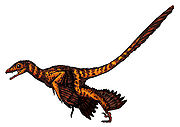 |
||
Utahraptor Utahraptor Utahraptor is a genus of theropod dinosaurs, including the largest known members of the family Dromaeosauridae. Fossil specimens date to the upper Barremian stage of the early Cretaceous period... |
Utah, USA |  |
||
Concornis Concornis Concornis was an enantiornithine bird. It lived during the Early Cretaceous, in the late Barremian stage or about 127-125 million years ago, and its remains are known from the Calizas de La Huérguina Formation at Las Hoyas, Cuenca province, Spain... |
Cuenca, Spain | |||
Iberomesornis Iberomesornis Iberomesornis is a monotypic genus of enantiornithine bird of the Cretaceous of Spain.In 1985 the fossil of Iberomesornis was discovered by Armando Díaz Romeral in the Early Cretaceous Calizas de La Huérguina Formation at Las Hoyas, Cuenca Province, east central Spain, which dates to the late... |
Cuenca, Spain | 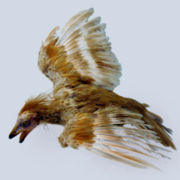 |
||
Harpymimus Harpymimus Harpymimus is a basal ornithomimosaurian theropod dinosaur from the Early Cretaceous Period of what is now Mongolia. Unlike later, more derived ornithomimosaurs, Harpymimus still possessed teeth, although they appear to have been restricted to the dentary of the lower jaw.-Discovery and naming:In... |
Gobi Desert, Mongolia |  |
||
Yixianosaurus Yixianosaurus Yixianosaurus is a maniraptoran theropod dinosaur genus from the Early Cretaceous of China.The type species, Yixianosaurus longimanus, was formally named and described by Xu Xing and Wang Xiaolin in 2003. Its partial skeleton was discovered in 2001, in Liaoning at Wangjiagou in northeastern China.... |
Liaoning, China | |||
Afrovenator Afrovenator Afrovenator is a genus of megalosaurid theropod dinosaur from the mid Jurassic Period of northern Africa. It was a bipedal predator, with a mouthful of sharp teeth and three claws on each hand... |
Niger, Africa | 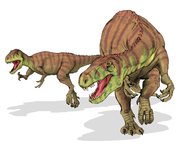 |
||
Sapeornis Sapeornis Sapeornis is a genus of primitive bird which lived during the Early Cretaceous . The genus contains only the species Sapeornis chaoyangensis which is known from fossils found in Jiufotang Formation rocks near Chaoyang, PRC... |
Liaoning, China | |||
Shenzhousaurus Shenzhousaurus Shenzhousaurus is a genus of basal ornithomimosaur from the Lower Cretaceous of China.The holotype was collected from near the bottom of the Yixian Formation at the Sihetun fossil site, Beipiao, western Liaoning Province... |
Liaoning, China | |||
Pelecanimimus Pelecanimimus Pelecanimimus is a genus of basal ornithomimosaurian theropod dinosaur from the Early Cretaceous of Spain... |
Cuenca, Spain | |||
Incisivosaurus Incisivosaurus Incisivosaurus is a genus of small, probably herbivorous theropod dinosaur from the early Cretaceous Period of what is now the People's Republic of China... |
Liaoning, China | |||
Baryonyx Baryonyx Baryonyx is a genus of carnivorous saurischian dinosaur first discovered in clay pits just south of Dorking, England, and later reported from fossils found in northern Spain and Portugal. It is known to contain only one species, Baryonyx walkeri... |
England, Spain, Portugal |  |
||
Chilantaisaurus Chilantaisaurus Chilantaisaurus is a genus of neovenatorid theropod dinosaur from the late Cretaceous Ulansuhai Formation of China . The type species, C. tashuikouensis, was described by Hu in 1964. Chilantaisaurus was a large theropod, estimated as weighing between and... |
China | |||
Calamosaurus Calamosaurus Calamosaurus was a genus of small theropod dinosaur from the Barremian-age Lower Cretaceous Wessex Formation of the Isle of Wight, England... |
Isle of Wight, England | |||
Prodeinodon Prodeinodon Prodeinodon is a dubious genus of theropod dinosaur from the Early Cretaceous of China and Mongolia. Three species have been identified, all three known only from tooth fragments showing no diagnostic features, making them difficult to classify, though they may belong to a carnosaur.The type... |
China, Mongolia | |||
Yaverlandia Yaverlandia Yaverlandia is a genus of theropod dinosaur. Known from a partial fossil skull found in Lower Cretaceous strata on the Isle of Wight, it was described as the earliest known member of the pachycephalosaurid family, but recent research by Darren Naish shows it to have actually been a theropod,... |
Isle of Wight, England | |||
Sinovenator Sinovenator Sinovenator is a genus of troodontid dinosaur from China. It is from the early Cretaceous Period. Two fossils were originally found in the Lujiatun Beds of the lower Yixian Formation in China, about 125 million years ago during the Aptian age.The type species, Sinovenator changii, was... |
Liaoning, China | |||
†ThyreophoraThyreophoraThe Thyreophora were a subgroup of the ornithischian dinosaurs...
| Thyreophora Thyreophora The Thyreophora were a subgroup of the ornithischian dinosaurs... of the Barremian |
||||
|---|---|---|---|---|
| Taxa | Presence | Location | Description | Images |
Liaoningosaurus Liaoningosaurus Liaoningosaurus is a very unusual ankylosaur from the Lower Cretaceous. The holotype IVPP V12560 , an essentially complete juvenile skeleton compressed on a slab, was collected from the Yixian Formation of Liaoxi, Yixian County, Liaoning Province, People's Republic of China.The type species... |
Liaoning, China | |||
Gastonia Gastonia Gastonia may refer to:Places:*Gastonia, North Carolina, United StatesIn biology:*Gastonia , a genus in the ivy or ginseng family*Gastonia , a genus of ankylosaur... |
Utah, USA | |||
Hoplitosaurus Hoplitosaurus Hoplitosaurus was a genus of armored dinosaur related to Polacanthus. It was named from a partial skeleton found in the ?Barremian-age Lower Cretaceous Lakota Formation of Custer County, South Dakota. It is an obscure genus which has been subject to some misinterpretation of its damaged remains... |
South Dakota, USA | |||
Polacanthus Polacanthus Polacanthus, deriving its name from the Ancient Greek poly-/πολυ- "many" and acantha/ακανθα "thorn" or "prickle", was an early armored, spiked, plant-eating ankylosaur from the early Cretaceous period. Early depictions often gave it a very vague head as it was only known from the rear half of the... |
England | |||
Sauroplites Sauroplites Sauroplites is a genus of ankylosaurid dinosaur from the Early Cretaceous. The type species, Sauroplites scutiger, was formally described by Bohlin in 1953, but is often considered a nomen dubium because it is based on fragmentary material. Sauroplites lived in what is now Gansu, China, during the... |
Gansu, China | |||
Craterosaurus Craterosaurus Craterosaurus was a genus of stegosaurid dinosaur. It lived during the Early Cretaceous around 145-136 million years ago. Its fossils were found in England... |
England | |||
Regnosaurus Regnosaurus Regnosaurus is a genus of herbivorous stegosaurian dinosaur that lived during the Early Cretaceous Period in what is now England.-Discovery and species:... |
Sussex, England | |||
Mammals
| Mammals of the Barremian | ||||
|---|---|---|---|---|
| Taxa | Presence | Location | Description | Images |
Eobaatar Eobaatar Eobaatar is a genus of extinct mammal from the Lower Cretaceous of Mongolia and Spain. It was a member of the also extinct order Multituberculata, and lived at the same time as some dinosaurs. It lies within the suborder Plagiaulacida and family Eobaataridae. The genus Eobaatar was named by... |
several species from Hauterivian to Albian Albian The Albian is both an age of the geologic timescale and a stage in the stratigraphic column. It is the youngest or uppermost subdivision of the Early/Lower Cretaceous epoch/series. Its approximate time range is 112.0 ± 1.0 Ma to 99.6 ± 0.9 Ma... |
Spain, Mongolia | 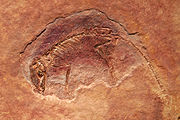 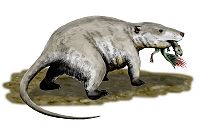 |
|
Eomaia Eomaia Eomaia is an extinct fossil mammal, discovered in rocks that were found in the Yixian Formation, Liaoning Province, China, and dated to the Barremian Age of the Lower Cretaceous about . The fossil is in length and virtually complete. An estimate of the body weight is between . It is exceptionally... |
||||
Repenomamus Repenomamus Repenomamus is the largest mammal known from the Cretaceous period of Manchuria, and it is the mammal for which there is the best evidence that it fed on dinosaurs. It is not possible to determine if Repenomamus actively hunted live dinosaurs or scavenged dead dinosaurs.-Paleobiology:Repenomamus... |
||||
†PterosaurPterosaurPterosaurs were flying reptiles of the clade or order Pterosauria. They existed from the late Triassic to the end of the Cretaceous Period . Pterosaurs are the earliest vertebrates known to have evolved powered flight...
s

- AzhdarchoideaAzhdarchoideaAzhdarchoidea is a group of pterosaurs within the suborder Pterodactyloidea.-Classification:Listing of families and genera after Unwin 2006 except where specified.* Superfamily Azhdarchoidea** Genus "Aurorazhdarcho"** Family Chaoyangopteridae...
incertae sedis: ChaoyangopterusChaoyangopterusChaoyangopterus is a genus of azhdarchoid pterodactyloid pterosaur known from a partial skeleton found in Liaoning, China. It was found in rocks of the Aptian-age Lower Cretaceous Jiufotang Formation of Dapingfang, Chaoyang....
, JidapterusJidapterusJidapterus is a genus of azhdarchoid pterodactyloid pterosaur from the Aptian-age Lower Cretaceous Jiufotang Formation of Chaoyang, Liaoning, China.... - CtenochasmatidaeCtenochasmatidaeCtenochasmatidae is a group of pterosaurs within the suborder Pterodactyloidea.-Classification:Listing of subfamilies and genera after Unwin 2006 unless otherwise noted.* Family Ctenochasmatidae** Elanodactylus** Gegepterus...
: BeipiaopterusBeipiaopterusBeipiaopterus is a genus of ctenochasmatid pterosaur from the Lower Cretaceous Yixian Formation in the People's Republic of China....
, LiaoxipterusLiaoxipterusLiaoxipterus is a genus of pterodactyloid pterosaur from the Barremian-Aptian-age Lower Cretaceous Jiufotang Formation of Chaoyang, Liaoning, China.... - IstiodactylidaeIstiodactylidaeIstiodactylidae is a small family of pterosaurs. This family was named in 2001 after the type genus Istiodactylus was discovered not to be a member of the genus Ornithodesmus....
: HongshanopterusHongshanopterusHongshanopterus is a genus of istiodactylid ornithocheiroid pterodactyloid pterosaur from the Lower Cretaceous Jiufotang Formation of Liaoning, China. It is based on IVPP V14582, a skull and neck vertebrae of a single individual. The teeth had triangular crowns and were flattened from mouth side...
,IstiodactylusIstiodactylusIstiodactylus was a medium sized pterosaur from the Early Cretaceous period.-History and species:In 1887 Harry Govier Seeley named the remains of a fossil pelvis discovered on the Isle of Wight, Ornithodesmus cluniculus, thinking it was a bird. In 1901 he considered that it might have been a...
,LongchengpterusLongchengpterusLongchengpterus was a genus of istiodactylid pterodactyloid pterosaur from the Barremian-Aptian-age Lower Cretaceous Jiufotang Formation of Chaoyang, Liaoning, China....
, NurhachiusNurhachiusNurhachius was a genus of istiodactylid pterodactyloid pterosaur from the Barremian-Aptian-age Lower Cretaceous Jiufotang Formation of Chaoyang, Liaoning, China.... - OrnithocheiridaeOrnithocheiridaeOrnithocheiridae is a group of pterosaurs within the suborder Pterodactyloidea. They were among the last pterosaurs to possess teeth.-Classification:Listing of genera after Unwin , except where noted.* Family Ornithocheiridae** ?Aetodactylus...
: HaopterusHaopterusHaopterus was a genus of ornithocheirid pterodactyloid pterosaur from the Barremian-Aptian-age Lower Cretaceous Yixian Formation of Liaoning, China....
, LiaoningopterusLiaoningopterusLiaoningopterus, sometimes misspelled "Liaoningopteryx", was a genus of ornithocheirid pterodactyloid pterosaur from the Barremian-Aptian-age Lower Cretaceous Jiufotang Formation of Chaoyang, Liaoning, China.... - OrnithocheiroideaOrnithocheiroideaOrnithocheiroidea is an extinct group of pterosaurs within the suborder Pterodactyloidea.-Locomotion:Ornithocheiroids, like other pterosaurs, are considered to have been skilled fliers as well as adept at moving on the ground...
incertae sedis: BoreopterusBoreopterusBoreopterus is a genus of ornithocheirid pterodactyloid pterosaur from the Barremian-Aptian-age Lower Cretaceous Yixian Formation of Dalian, Liaoning, China.... - PterodactyloideaPterodactyloideaPterodactyloidea forms one of the two suborders of pterosaurs , and contains the most derived members of this group of flying reptiles...
incertae sedis: FeilongusFeilongusFeilongus is an extinct genus of ctenochasmatoid or ornithocheiroid pterodactyloid pterosaur from the Barremian-Aptian-age Lower Cretaceous Yixian Formation of Beipiao, Liaoning, China.... - TapejaridaeTapejaridaeTapejaridae are a family of pterodactyloid pterosaurs from the early Cretaceous period. Members are currently known from Brazil and China, where the most primitive genera are found, indicating that the family has an Asian origin....
: HuaxiapterusHuaxiapterus"Huaxiapterus" is a genus of tapejarid pterodactyloid pterosaur from the Aptian-age Lower Cretaceous Jiufotang Formation of Chaoyang, Liaoning, China. It is the second genus of tapejarid from this formation, after Sinopterus, and may be more derived. Two species are known.The type species of...
, SinopterusSinopterusSinopterus was a genus of tapejarid pterodactyloid pterosaur from the Aptian-age Lower Cretaceous Jiufotang Formation of Chaoyang, Liaoning, China. Three species have been classified in this genus, though only two are generally considered to be valid...
Literature
(1907): Le Barrémien supérieur à faciès Urgonien de Brouzet-lès-Alais (Gard). Mémoires de la Société Géologique de France, Paléontologie 15(37): 5-42. ; (2004): A Geologic Time Scale 2004, Cambridge University PressCambridge University Press
Cambridge University Press is the publishing business of the University of Cambridge. Granted letters patent by Henry VIII in 1534, it is the world's oldest publishing house, and the second largest university press in the world...
. (2006): Assessment of diachronism of biostratigraphic boundaries by magnetochronological calibration of zonal scales for the Lower Cretaceous of the Tethyan and Boreal belts. Doklady Earth Sciences 409(6): 843-846.
External links
- GeoWhen Database - Barremian
- Mid-Cretaceous timescale, at the website of the subcommission for stratigraphic information of the ICS
- Stratigraphic chart of the Lower Cretaceous, at the website of Norges Network of offshore records of geology and stratigraphy

